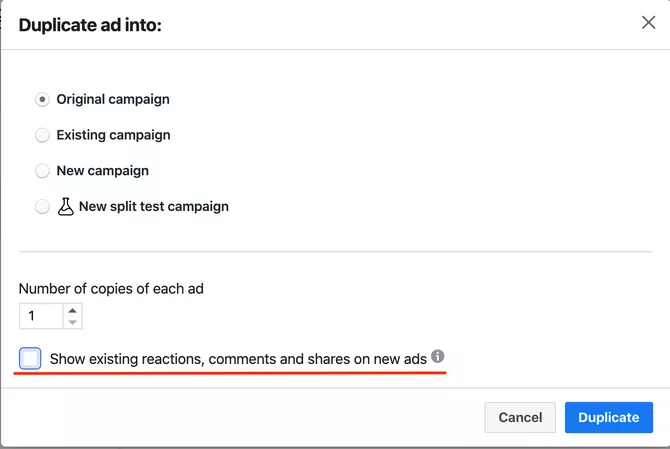When it comes to advertising in Facebook, everything is important. Before investing money, we need to take a step back and decide which factors and metrics predict profitability of our efforts.
Ctr., Frequency, CPC, Engagement rate.… Facebook shows so many metrics to follow!
However, we are going to discover one of the factors that usually stays undisclosed.
I personally has been running ads for years and without guessing that there was something so important that affected my advertising activity so much.
It's about comments.
Do comments below your advertising posts help you produce the best bang for your buck?
There’s only one way to find out, and that’s by putting $1,000 of ad dollars down on the table and letting the Facebook A/B testing tool find it out.
We decided to test the hypothesis that nobody read comments below ads.
In this experiment, we decided to test “Bad comments” against “No comments” ad groups. To make the results meaningful for the $1,000 of ad spend, we decided to include only one ad per ad group.
- With Bad Comments, we selected an ad post where deleted all positive and left only negative comments. The advertising post (the Dark post) was quite old and had around 50 negative comments.
- The "No comments" group we've got by copying the Bad comments group without transferring reactions, comments and shares made before.
In this way we had two identical ad groups with the same targeting, ads and optimisation options. The final set-up was made with the Facebook split test feature, where we chose creatives as the testing variables.
The settings were:
- Budget: $150 a day, campaign budget optimisation, Highest value or lowest cost bid strategy
- Countries: USA
- Language: English
- Duration: 7 days
- Total budget: $1,000
- Optimization strategy: App installs
Hypothesis
We hypothesised that nobody read comments before clicking on ads. Going further we assumed that comments (doesn't matter good or bad) could make a positive impact for ads. It could get higher relevance rankings, which in turn could result in a lower CPM and cost per click and therefore more installs.
Our prediction was that Bad Comments (Version A) group would give a lower cost per install (CPI) than exact No Comments (Version B), because nobody read comments.
Bad Comments ad had a lot of shares and likes, which would have to make it more attractive for the Facebook Algorithm. Bad comments would have the potential to show up more often with lower CPM, so it would be able to make bigger number of installs with the same campaign budget.
What we couldn’t predict was the expected difference in CPI, so in this experiment we wanted to investigate exactly how much more expensive No Comment ad could be.
Results
Here are the overall results of the campaign:
From the result table, we can see that the No comments campaign won the test and produced 341 installs at $1.46, however, the CPM for campaigns were nearly identical.
Turning our attention to the difference in CPI and the level of confidence of 83% that the No Comments ad was better.
The most important fact is that the CPM for each of the versions is identical. The ads were similar for the Facebook Algorithm, the amount of engagement on each ad did not make any difference in deliverability.
Our hypothesis that nobody read comments was not confirmed.
The result indicates that comments make a real difference and are of critical importance to users. Looks like customers read comments before clicking on ads and bad comments give the impression of a product before visiting a landing page.
Conclusion
The main conclusion - comments matter. Facebook users read comments and when comments are not pleasant it results in a higher cost per conversion. When the first touch point with your customers is Facebook Ads, the second one is comments below.
We used to make ads as engaging as possible and now we have to communicate through comments with our customers to keep them loyal.
This is why it’s important to have a dedicated resources and strategy to deal with negative and encourage positive comments.
Dive into our glossary for key SMM definitions to boost your social media strategy!
Summary
- Facebook comments have a significant impact on advertising activities. People read comments before installing and, probably, purchasing.
- It is better to start a new campaign without transferring comments, likes and shares if you are not confident in your posts.
- Social proofs matter only if you have good reputation, you don't have anything to hide and your customers love you.
- The negative impact of bad comments is much stronger for your potential customers that the positive signals to the Facebook algorithm.
- A comments section is a perfect place to communicate with your audience and you should be dynamic to improve advertising results.
Related Articles
Display Advertising Effectiveness Analysis: A Comprehensive Approach to Measuring Its Impact
In this article, I will explain why you shouldn’t underestimate display advertising and how to analyze its impact using Google Analytics 4
Generative Engine Optimization: What Businesses Get From Ranking in SearchGPT
Companies that master SearchGPT SEO and generative engine optimization will capture high-intent traffic from users seeking direct, authoritative answers
From Generic to Iconic: 100 Statistics on Amazon Marketing for Fashion Brands
While traditional fashion retailers were still figuring out e-commerce, one company quietly revolutionized how U.S. consumers shop for everything from workout gear to wedding dresses







